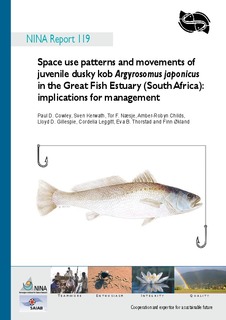| dc.description.abstract | Cowley, P.D., Kerwath, S., Næsje, T.F., Childs, A.-R., Gillespie, L.D., Leggitt, C., Thorstad, E.B. and Økland, F. 2006. Space use patterns and movements of juvenile dusky kob Argyrosomus japonicus in the Great Fish Estuary (South Africa): implications for management. - NINA Report 119. 32 pp.
The space use patterns and horizontal movements of juvenile dusky kob Argyrosomus japonicus, an important fishery species, were studied in the Great Fish Estuary in South Africa (33º 29’ 28’’ S and 27º 13’ 06’’ E) were studied with an array of 11 moored data-logging acoustic receivers (Vemco VR2s). Twenty nine individuals (307 – 400 mm TL) were captured using hook and line methods, surgically equipped with acoustic transmitters, and then released at their catch site within the estuary. Data on 25 individuals was subsequently analysed for up to 195 days (3 March – 14 September 2004). Tagged fish made extensive use of the estuary from the mouth to between 6.4 and 10.3 km upstream. All fish were recorded throughout the lower 5 km of the estuary. Collectively, the tagged fish spent approximately equal proportions of time at each of the seven VR2s located between 0.5 and 6.5 km from the mouth. Periods of limited movements (stationary behaviour) were mostly short and restricted to between 3 and 18 hours. Fifteen fish undertook sea trips with a mean duration of 3.5 days, while four individuals made excursions into freshwater (mean duration = 7.3 days). Observations of daily movements over an arbitrarily chosen one-week period revealed three behavioural patterns (i) stationary behaviour, (ii) one longitudinal excursion either up or down the estuary, and (iii) two longitudinal rhythmic excursions up and down the estuary. The ultimate fate of the fish at the end of the 195 day study period revealed that 16 (64%) left the estuary and never returned; five (20%) were alive and still in the estuary and four (16%) were captured in the fishery during the study period. A comparison between spatial trends in the distribution of fish and angling effort revealed that juvenile dusky kob were most susceptible to capture by recreational boat anglers (p < 0.05), while no significant correlations were observed for recreational and subsistence shore angling effort. The dependence on nursery habitat areas and their vulnerability to capture in estuaries can result in reduced catches in coastal and offshore areas. This study emphasizes the importance of establishing estuarine protected areas as a fisheries management objective to assist with the rebuilding of depleted fish stocks such as dusky kob. acoustic telemetry, movement behaviour, argyrosomus japonicus, area use, fisheries management | nb_NO |
